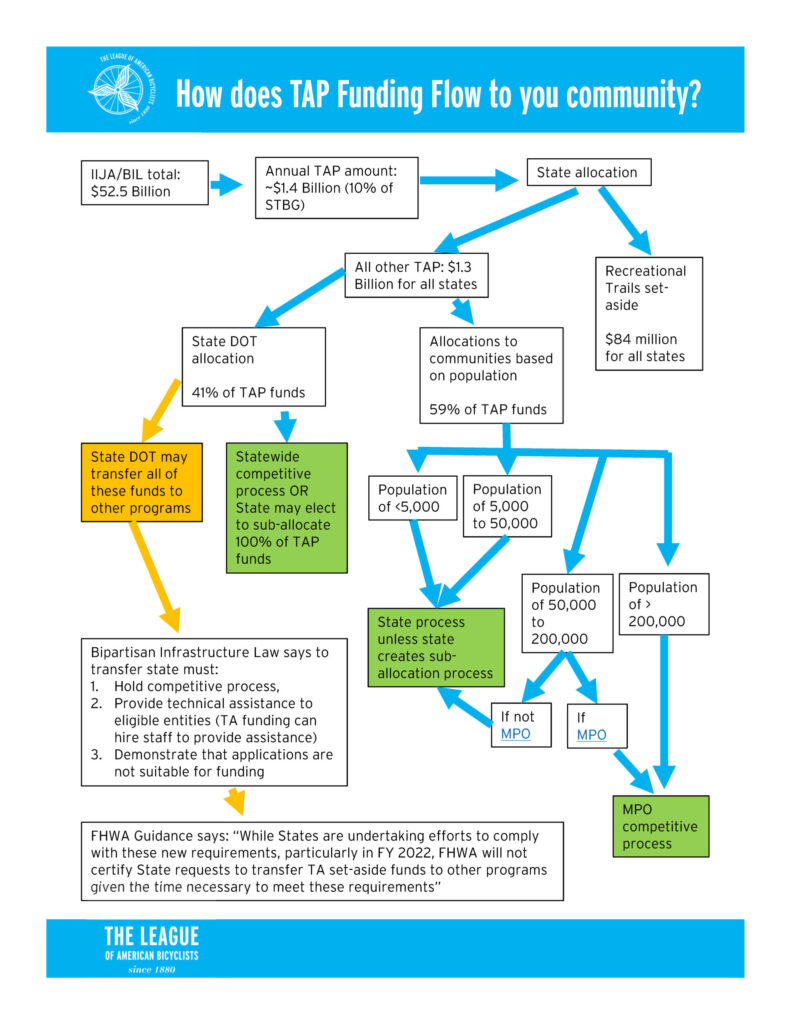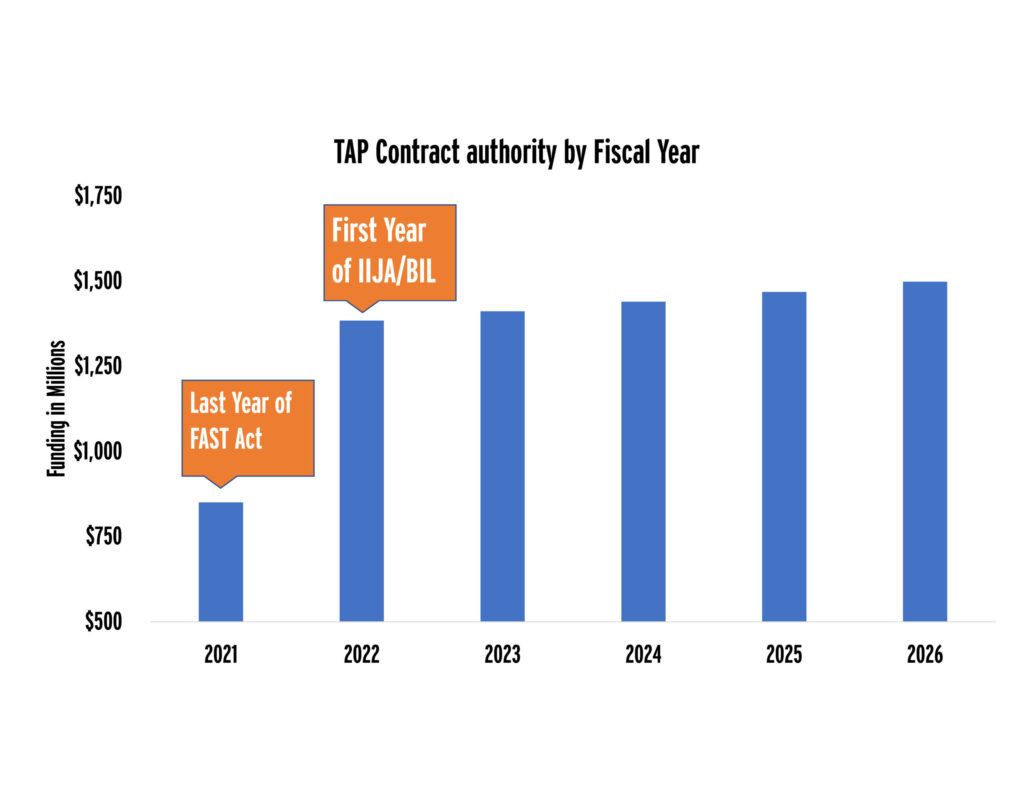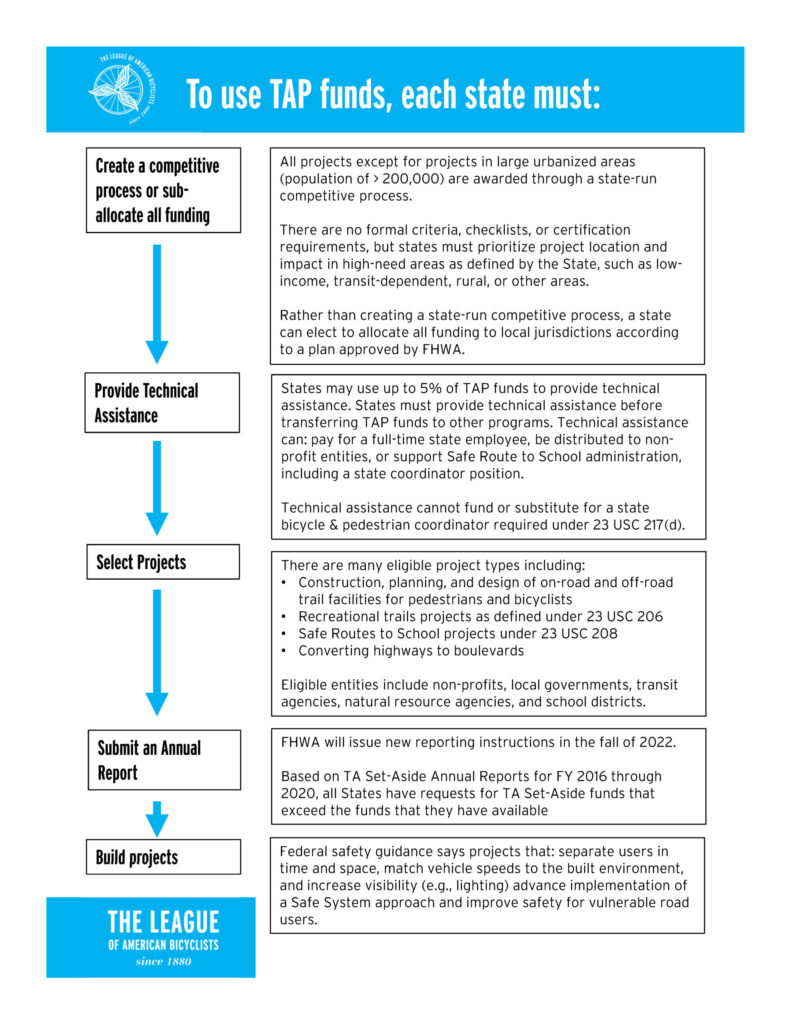What’s new? Why TAP?
The Transportation Alternatives Program (TAP) provides roughly $1.3 Billion each year for safety projects throughout the United States. Since its creation in 1991 under the Intermodal Surface Transportation Efficiency Act of 1991 (ISTEA), a version of TAP has been the most common source of federal funds for bicycling and walking projects. Over time, TAP has been known by several names and is currently a set-aside under the Surface Transportation Block Grant Program. You may also see TAP referred to as the Transportation Alternatives Set-Aside (TASA) or simply TA.
Under the Infrastructure Investment and Jobs Act (IIJA), also known as the Bipartisan Infrastructure Law (BIL), there are three reasons that people interested in improving bicycling and walking should discuss TAP with their local elected officials and agency staff.
New Emphasis on High Need Areas
Under the IIJA/BIL every state and Metropolitan Planning Organization must develop a competitive process for the awarding of TAP funds. While requiring a competitive process has been a feature of TAP since 1991, Congress has now added a requirement that the competitive process shall include prioritization of project location and impact in high-need areas as defined by the State, such as low-income, transit-dependent, rural, or other areas.
How high-need areas are defined is a state decision and can reflect the needs of each state. Transportation inequities have been found to be associated with many different types of people and communities. The United States Department of Transportation has an Equity Action Plan that focuses on Wealth Creation, the Power of Community, Interventions, and Expanding Access. The USDOT Equity Action Plan supports Executive Order 13985, "Advancing Racial Equity and Support for Underserved Communities Through the Federal Government," which defines underserved communities as "populations sharing a particular characteristic, as well as geographic communities, that have been systematically denied a full opportunity to participate in aspects of economic, social, and civic life."
New Authority for Local Projects
Several provisions of the IIJA/BIL were enacted to provide greater authority to local communities that would like to implement bicycling and walking projects.
Increased Authority for Metropolitan Planning Organizations
Under the IIJA/BIL, the percentage of TAP funds sub-allocated by population increased to 59%. This means that local communities receive a greater percentage of funds and that the state Department of Transportation has a smaller percentage of funds that can be spent outside of communities. There are sub-allocations for communities with populations of less than 5,000; between 5,000 and 50,000; between 50,000 and 200,000; and 200,000 or more people.
For the largest communities, with 200,000 or more people or who are otherwise included in a Metropolitan Planning Organization (MPO), the IIJA/BIL also requires
States to provide specified amounts of obligation authority to those communities. Obligation authority provides the authority to create a legal commitment that the Federal government will pay for the Federal share of a project’s eligible cost. Under the previous transportation bill, MPOs were able to administer their own competitive processes for TAP awards, but were not guaranteed the ability to obligate the federal government to pay for the federal share of their selected projects. The change to obligation authority under the IIJA/BIL brings TAP in-line with other federal programs and ensures that MPOs have authority to administer their own projects.
Potential for 100% Funding Allocation to Communities
Under the IIJA/BIL, a state may allocate 100% of TAP funds if the state submits a plan to the USDOT Secretary of Transportation describing:
- How the funds will be allocated to counties, metropolitan planning organizations, regional transportation planning organizations, or local governments;
- How those entities will carry out a competitive process to select projects for funding and report selected projects;
- The legal, financial, and technical capacities of those entities;
- How input was gathered from those entities to ensure that they can comply with the requirements;
- How the state will comply with TAP’s Annual Reporting requirement; and
- The USDOT Secretary of Transportation approves the plan.
TAP is administered as a federal program with its own distinct planning process. To use TAP funds states must follow requirements related to annual reporting and the administration of a competitive process. Learn more about the structure and rules of TAP in the flowcharts and table below.
Flowchart on How Funding gets to Communities

How federal law distributes TAP funds to communities of various sizes

